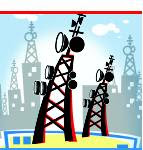Software may replace mobile phone towers
Scientists have developed a new mobile technology which they claim is set to improve calls during disasters by allowing the transmission of signals with -out nearby cell phone towers.
An international team, led by Flinders University, has created the software which can run on "off-theshelf" mobile phones and allow them to relay calls for one phone to another -- without the presence of mobile phone towers in the vicinity –– before re-connecting with an operating mobile phone tower.
"Our technology allows the signal from the working towers to be relayed into areas lacking signal, allowing calls in and out of affected areas. What is amazing is that we have programmed fairly ordinary mobile telephones to perform this function, without using any specialised hardware," Dr Paul Gardner-Stephen, who led the team, said. He added: "We are excited about the potential of our technology to help at the time of crisis. We are committed to make the technology freely available.
"Any telephone carrier or handset manufacturer that wishes to incorporate our technology into their products is free to do so, and indeed we would be delighted to assist them in that process."
The technology also has the potential to dramatically improve mobile telephone coverage in many rural and remote locations where a signal is available only from limited locations in a community or with a frustratingly weak signal, say the scientists.
"Phones running our software relay calls between themselves. If even just one of those can see a cell tower, then calls can be with any of the phones, thus sustaining communications in affected areas. A balloon is not necessary; a phone running our software at any vantage point can suffice," he said. AGENCIES
An international team, led by Flinders University, has created the software which can run on "off-theshelf" mobile phones and allow them to relay calls for one phone to another -- without the presence of mobile phone towers in the vicinity –– before re-connecting with an operating mobile phone tower.
"Our technology allows the signal from the working towers to be relayed into areas lacking signal, allowing calls in and out of affected areas. What is amazing is that we have programmed fairly ordinary mobile telephones to perform this function, without using any specialised hardware," Dr Paul Gardner-Stephen, who led the team, said. He added: "We are excited about the potential of our technology to help at the time of crisis. We are committed to make the technology freely available.
"Any telephone carrier or handset manufacturer that wishes to incorporate our technology into their products is free to do so, and indeed we would be delighted to assist them in that process."
The technology also has the potential to dramatically improve mobile telephone coverage in many rural and remote locations where a signal is available only from limited locations in a community or with a frustratingly weak signal, say the scientists.
"Phones running our software relay calls between themselves. If even just one of those can see a cell tower, then calls can be with any of the phones, thus sustaining communications in affected areas. A balloon is not necessary; a phone running our software at any vantage point can suffice," he said. AGENCIES

No comments:
Post a Comment